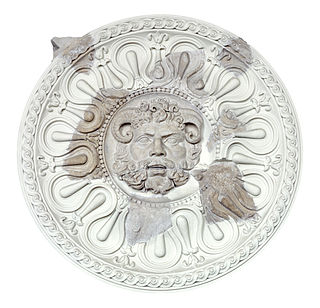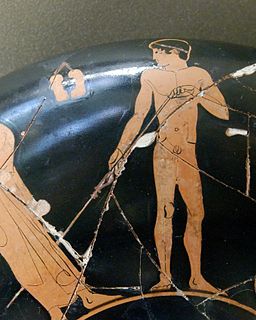 W
WA bident is a two-pronged implement resembling a pitchfork. In classical mythology, the bident is a weapon associated with Hades (Pluto), the ruler of the underworld. Likewise, the three-pronged trident is the implement of his brother Poseidon (Neptune), god of the seas and earthquakes, and the lightning bolt, which superficially looks as if it has one prong, is a symbol of Zeus.
 W
WA cestus or caestus is an ancient battle glove, sometimes used in pankration. They were worn like today's boxing gloves, but were made with leather strips and sometimes filled with iron plates or fitted with blades or spikes, and used as weapons.
 W
WThe Claw of Archimedes was an ancient weapon devised by Archimedes to defend the seaward portion of Syracuse's city wall against amphibious assault. Although its exact nature is unclear, the accounts of ancient historians seem to describe it as a sort of crane equipped with a grappling hook that was able to lift an attacking ship partly out of the water, then either cause the ship to capsize or suddenly drop it. It was dropped onto enemy ships, which would then swing itself and destroy the ship.
 W
WIn the military of classical antiquity, a clipeus was a large shield worn by the Greek hoplites and Romans as a piece of defensive armor, which they carried upon the arm, to protect them from the blows of their enemies. It was round in shape and in the middle was a bolt of iron, or of some other metal, with a sharp point. The clipeus was more-or-less identical to the earlier aspis.
 W
WThe Dendra panoply or Dendra armour is an example of Mycenaean-era panoply made of bronze plates uncovered in the village of Dendra in the Argolid, Greece.
 W
WA greave or jambeau is a piece of armour that protects the leg.
 W
WHemithorakion was an ancient Greek half-armour that covered the midriff or abdomen area. The inventor is believed to be the Thessalian king Jason of Pherae. It was an equipment of the officers, not of common soldiers. Plutarch records that hemithorakia were worn by Pelopidas and his soldiers during the battle to expel the Spartans from Thebes in 379, a battle in which Pelopidas and his men disguised themselves as women. In art, it is generally seen on female warriors, which corroborates Plutarch's account. Instances in art include several vase depictions on Amazons. An unusual intact terra cotta mold from Morgantina, dating from the first half of the fourth century, shows Artemis wearing the hemithorakia while sacrificing a hind.
 W
WA hydraulic telegraph is either of two different hydraulic-telegraph telecommunication systems. The earliest one was developed in 4th-century BC Greece, while the other was developed in 19th-century AD Britain. The Greek system was deployed in combination with semaphoric fires, while the latter British system was operated purely by hydraulic fluid pressure.
 W
WA javelin is a light spear designed primarily to be thrown, historically as a ranged weapon, but today predominantly for sport. The javelin is almost always thrown by hand, unlike the bow and arrow and slingshot, which shoot projectiles from a mechanism. However, devices do exist to assist the javelin thrower in achieving greater distance, generally called spear-throwers.
 W
WA greave or jambeau is a piece of armour that protects the leg.
 W
WThe term kopis in Ancient Greece could describe a heavy knife with a forward-curving blade, primarily used as a tool for cutting meat, for ritual slaughter and animal sacrifice, or refer to a single edged cutting or "cut and thrust" sword with a similarly shaped blade.
 W
WThe Ksour Essef cuirass is an ancient breastplate found in a Punic tomb in 1909 not far from Ksour Essef, Tunisia.
 W
WThe linothorax is a type of upper body armor used throughout the ancient Mediterranean world. The term linothorax is a modern term based on the Greek λινοθώραξ, which means "wearing a breastplate of linen"; however, the actual ancient term for this type of armor is unclear. The term thorax was the word for breastplate during this era and was traditionally made of metal in most contexts. The linothorax were made of linen glued in layers with animal fat, and eventually adopted by many armies.
 W
WMakhaira is a term used by modern scholars to describe a type of ancient bladed weapon, generally a large knife or sword with a single cutting edge.
 W
WThe mesangylon was a javelin with a strap for throwing it by. Its name is attested, among others, in the works of Euripides, Polybius and Arrian. It is one of the weapons used in Alexander's experimental phalanx
 W
WIn classical antiquity, the muscle cuirass, anatomical cuirass, or heroic cuirass is a type of cuirass made to fit the wearer's torso and designed to mimic an idealized male human physique. It first appears in late Archaic Greece and became widespread throughout the 5th and 4th centuries BC. Originally made from hammered bronze plate, boiled leather also came to be used. It is commonly depicted in Greek and Roman art, where it is worn by generals, emperors, and deities during periods when soldiers used other types.
 W
WPteruges refers to strip-like defences for the upper parts of limbs attached to armor in the Greco-Roman world.
 W
WThe sambuca was a ship-borne siege engine which was invented by Heracleides of Tarentum and was first used unsuccessfully by Marcus Claudius Marcellus during the Roman siege of Syracuse in 213 BC.
 W
WThe xiphos is a double-edged, one-handed Iron Age straight shortsword used by the ancient Greeks. It was a secondary battlefield weapon for the Greek armies after the dory or javelin. The classic blade was generally about 45–60 cm (18–24 in) long, although the Spartans supposedly started to use blades as short as 30 cm (12 in) around the era of the Greco-Persian Wars. The xiphos sometimes has a midrib, and is diamond or lenticular in cross-section. It was generally hung from a baldric under the left arm. The xiphos was generally used only when the spear was broken, taken by the enemy, or discarded for close combat. Very few xiphoi seem to have survived.
 W
WThe xyston (Ancient Greek: ξυστόν "spear, javelin; pointed or spiked stick, goad ", a derivative of the verb ξύω "scrape, shave", was a type of a long thrusting spear in ancient Greece. It measured about 3.5–4.25 meters long and was probably held by the cavalryman with both hands, although the depiction of Alexander the Great's xyston on the Alexander Mosaic in Pompeii, suggests that it could also be used single handed. It had a wooden shaft and a spear-point at both ends. Possible reasons for the secondary spear-tip were that it acted partly as a counterweight and also served as a backup in case the xyston was broken in action. The xyston is usually mentioned in context with the hetairoi, the cavalry forces of ancient Macedon. After Alexander the Great's death, the hetairoi were named xystophoroi because of their use of the xyston lance. In his Greek-written Bellum Judaicum, the Jewish historian Flavius Josephus uses the term xyston to describe the Roman throwing javelin, the pilum.